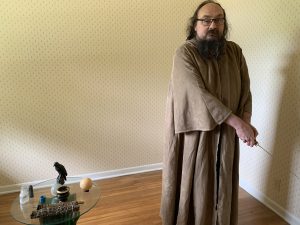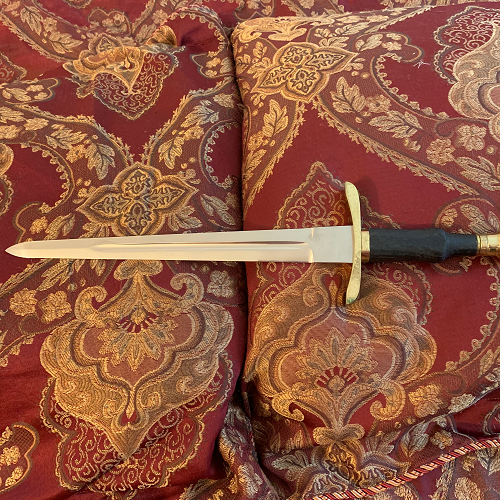Every now and then — and especially around this time of year — someone decides to write a news article about Paganism and witchcraft. On occasion, it’s just an informational peace, noting our existence as if we’re some sort of curiosity. On rare occasion, we even see an article by one of own that is pretty positive.
Sadly, there are also a considerable number of articles — typically written by Christians — that are critical and and even downright defamatory toward us. In this blog post, I will be taking a closer look at one such article. I should note that this particular article focuses primarily on the New Age movement and Paganism — also called Neopaganism in the article. It mentions witchcraft a few times, but does not substantially focus on it as a potentially separate identity. (After all, some Pagans are witches, but not all Pagans are witches nor are all witches Pagan.)
The article starts off by talking about how children often grew up seeing the image of witches as evil characters in folk tales and other literature, then moves on to the author learning later in life that some people identify as witches, “but they weren’t all that bad.” The italicization of “that” makes me smirk. Thank you, Emmy Griffin. You are too kind.
Griffin closes here first paragraph with the claim that “Neopaganism and New Age are trying to supplant Christianity in America.” What’s interesting me me is that this is the sudden switch from talking specifically talking about witches to talking about Neopaganism and the New Age. She uses the terms interchangeably as if they all mean the same thing. They do not, and this choice immediately leaves me wondering just how reliable her sources are.
What may be more interesting, however, is Griffin’s assertion that we are trying to supplant Christianity. I do not think that this is an accurate statement. In fact, I would argue that it is a matter of projection. The vast majority of Pagan religions — and the New Age movement as well — are non-proselytizing. We do not seek converts. This is not to say that we don’t welcome newcomers or those interested in joining us. But we are also perfectly happy to let people stick with whatever religion they wish to, or no religion at all. Instead, it is Christians who often seek to convert others and even hold the belief that everyone must convert or face the wrath of the Christian god as a central tenet of their religion. So what Griffin is expressing here is a fear that others will treat her the way she and her fellow Christians treat others.
There may be a second fear here, however. And that is the fear that Christianity — or at least her brand of that religion — cannot compete with Paganism and New Age religions and people will find the latter more preferable to her own faith. But surely the Pagans and the New Agers cannot be held responsible for her own religions failure to remain competetive in today’s spiritual marketplace.
Griffin spends the next paragraph giving statistics on what various people believe in various religions or are atheists, presumably to back up her claim that we’re all seeking to supplant Christianity rather than treating it as evidence that other religions and even nonreligious belief is more appealing than Christianity.
Weirdly, Griffin then takes a jab at Pagans and New Agers by invoking an old quote by G.K. Chesterton:
As Christian apologist G.K. Chesterton once said, “When men stop believing in God they don’t believe in nothing; they believe in anything.”
This quote reeks of Christian supremacy, suggesting that other belief systems in general and Paganism and New Age spirituality in particular are somehow inferior and for gullible people. It seems like a rather harsh and unfounded assessment on both Chesterton and Griffin. It demonstrates a sort of aggressive dismissiveness and condescension that likely does nothing to help attract people to her own religion.
Griffin then goes on to give her explanation of what Paganism and the New Age movement is, citing an LA Progressive article as her source. This is an interesting choice because Bruce Larro, the author of that article, does not himself seem to be part of either movement. To Larro’s credit, his own research on both movements included looking into the actual words of members of those movements. So in this sense, Griffin’s choice of Larro as a source is far to superior to someone like Mike Warnke or Bill Schnoebelen. However, the fact that she used a non-primary source rather than seeking out actual Pagans (to whom she refers as “Newpaganists” later in the article, again calling her knowledge and credibility into question) and New Agers directly is questionable.
This is especially questionable when one reads Larro’s article. While considerate and even mostly positive, Larro’s article has a clear agenda: To consider the two movements through the lens of socialism and to consider whether either movement could serve as a spiritual or religious vehicle to support the socialist movement. I suspect that this is exactly the reason Griffin chose this article as her source. Socialism is another bogeyman of conservative Christians and they often like to link all of their bogeyman into a single (often Satanic) conspiracy. This hypothesis finds support in the following paragraph found a little later in the article:
Climate change, transgenderism, abortion, cancel culture, and even critical race theory (CRT) have their poisonous roots in New Age and neopagan religious ideas. Under the auspices of New Age fall CRT and cancel culture. The tenets of CRT and cancel culture emphasize the importance of “lived experience,” “special knowledge,” and manifestation of your best life. Anyone who dares to contradict these deserves to be canceled because they are evil according to New Age. Ironically, New Age preaches that it can help its adherents self-help their way out of their problems while also creating a victim class.
Had Griffin geared her research toward exploring the truth rather than mining for quotes and sources that fit her narrative, she might have discovered that opinions on many of those topics vary greatly among Pagans (and presumably New Agers as well). The accusation that either movement acts with a hive mind with no disagreements is woefully ignorant. And again, I posit that this is more likely a matter of projection on Griffin’s part: She assumes that Pagans demand conformity of opinion because her own brand of Christianity demands it.
Griffin then mentions the former astrologist Angela Ucci. I had never heard of Angela Ucci before reading this article and a Google search of her brought up little more than YouTube videos of interviews she’s given and her own social media pages. Beyond that, she seems like a total unknown, which raises the question of why Griffin chose such a relatively unknown person to hold up her experience and try to paint it as universal among New Agers. Again, this feels more like Griffin cherry-picking a testimony that fits her desired narrative rather than an honest attempt at research or presenting factual information.
Griffin hen goes on to give examples that she considers evidence of the two movements’ growing influence, citing media portrayals of witches and the portrayal of witches and Pagans in a positive light, something which seems to bother Griffin greatly despite the fact that she doesn’t articulate why that is as well. Instead, she offers barbs like “it’s the embodiment of chaos.” Which is a particularly ironic in light of her previous claims that Paganism and the New Age movement are a monolith which demands adherence to the group think. The idea that everyone must think alike and chaos (or total individualism, as Griffin mentions later) are fairly incompatible concepts. Griffins accusations are rather inconsistent and incoherent if one merely scratches the surface a bit.
Griffin then invokes the specter of the Satanists, mentioning a specific incident in Texas:
This rise in New Age/mysticism and paganism is getting ever more prevalent in the mainstream culture. In Tyler, Texas, over the weekend, satanists (who would go into the neopaganism column) had a booth at a Pagan Pride event. The Morning Telegraph, a local paper covering the event, quoted the event organizer, Raynie Castañeda, as saying the event was not satanic, just an alternative celebration of non-Abrahamic religions. She said: “There’s kids trick-or-treating, people getting their faces painted. … We’re not doing anything satanic or any crazy rituals. We’re just existing.” She must have missed the part where the Satanic temple booth was preforming “unbaptisms” for $10 and handing out certificates that literally said: “All bonds of servitude have been broken. Power and agency have been restored. Thyself is thy master. Hail Satan!” Maybe Castañeda doesn’t understand what “satanic” is?
There’s a lot to unpack in this quote and I’m not sure I’ll be able to get to it all, but I at least want to start that process. The first thing to note is that she uses the activities of a single group and their booth to paint a picture of all the other Pagans attending the event. Again, this is a case of Griffin cherry picking examples that fit her narrative and ignoring anything that might run counter to it.
I will also note that Griffin seems to either be ignorant of the fact that The Satanic Temple is primarily an atheistic form of Satanism or is intentionally ignoring or even erasing that fact. When most members of the Satanic Temple say “Hail Satan,” they are not literally talking about the Christian devil, but a concept or a principle. So yes, even the Satanists in this story most likely do not consider themselves “satanic” in the sense that Griffin is attempting to imply. Then again, Griffin seems to think that anything that doesn’t fall into step with her own brand of Christianity is satanic, so maybe they do. But I don’t find that a particularly useful or honest use of the word on her part.
The concept of “unbaptisms” — which Griffin seems to find troubling and possibly offensive — is an interesting concept. As someone who had a bad (though not as bad as others) experience in evangelical Christianity, I can certainly see what value some people might find value in a ritual act of breaking ties with their former, toxic religious experiences. So Griffin cries fowl and animosity toward Christianity without exploring why some might justifiably feel such animosity.
Griffin closes her article with the unfounded and unsubstantiated claims that Pagans and New Agers are seeking to destroy American soceity and that neither movement offers true happiness. This later is a claim that I hear often, but ignores the many Pagans (and presumably New Agers) that are quite happy and lived fulfilled lives. But again, our experiences and our truths do not fit Griffin’s narrative so we must either be ignored or presumed to be lying.
In closing, I will just note that I am again disappointed in just how uninterested many Christians are in pursuing and presenting the truth despite their many claims to the contrary. There is so much dishonesty in Griffin’s article and the way that she presents her case that I struggle to believe that it is not intentional.




